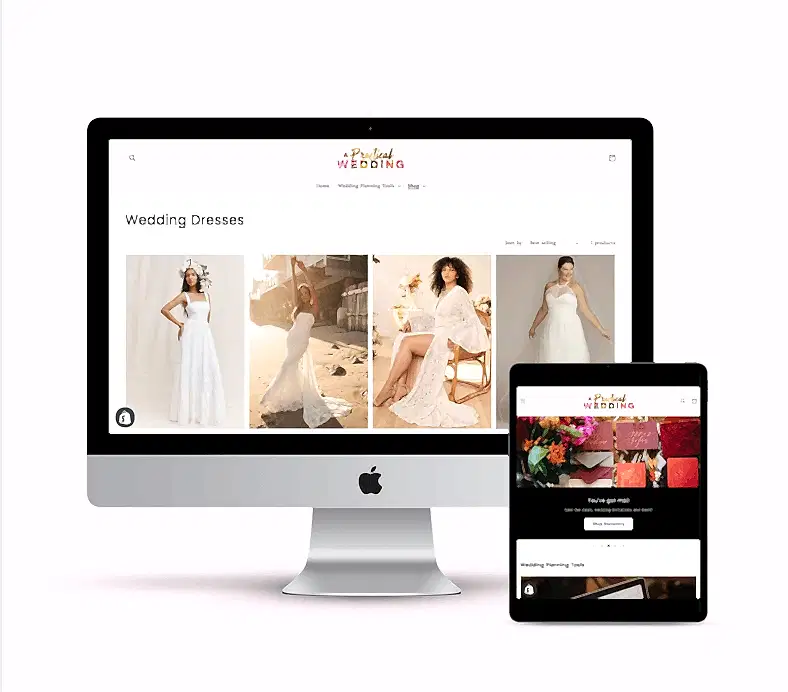

The end of 2011 brought a ton of change to my marriage. Michael and I moved to California to take advantage of an exciting new job offer for him. We got a roommate. And I started working part time at APW while freelancing at my old marketing job and trying to build up my photography business on the West Coast. Sound like a lot? It was. But even though I was holding down three jobs that easily combined to fill more than a forty-hour workweek, for the first time since graduating college, I wasn’t contributing a substantial percentage of our family’s income.
Before this move, I assumed we were just one of those couples who never fought about money. But this sudden change in our earning dynamic totally shifted how each of us approached our shared finances, in ways that weren’t always aligned, and the tensions arising from these changes persisted even as I started working full time and our financial situation changed for the better. So last year, when we got real about improving certain parts of our marriage, at the very top of our list was money.
As I wrote a few months ago, one of the key parts of getting our finances in order was getting ourselves set up with the app You Need a Budget. For those of you who have been asking how YNAB works, here’s the basic breakdown of what it does and why it helped us:
- Put simply, YNAB is a budgeting tool you can use on both your computer and your phone. The core purpose of YNAB is to help switch you from spending money based on what you think you can afford based on the number in your bank account, to spending money based on what you know you can afford because you’ve budgeted it. YNAB is particularly well suited for anyone trying to get out of debt (us) or living paycheck to paycheck (also us) or otherwise making good money and never seeming to be able to save any of it (ugh, us).
- The way YNAB works is this: You get your paycheck every two weeks (or whatever). And as soon as you get your paycheck, every dollar of it gets assigned a job in the YNAB app. So, for example, while you may have $2,000 in your bank account just hanging out from that recent paycheck, you’re going to allocate $700 in YNAB for for rent, $300 for your car payment, $100 for the cable bill, $200 for the car repairs you’re saving up for, and maybe $100 for impulse shopping. By the time you’re done allocating your budget, that $2,000 in your bank account is irrelevant, because now YNAB will tell you how much money you have to spend in each category of your life.
- As you spend throughout the month, you log transactions in real time as you go (or our preferred method—when your bank account statements update at the end of the day). Go over budget in a category? Not a problem, YNAB is designed to be flexible. But flexible in “we’ll need to move some money from our restaurant budget to cover the extra groceries” kind of way, instead of a “let’s put it on the credit card and think about it next month” kind of way.
- YNAB is not fully automated. It doesn’t pull information from your bank account every time you make a purchase—instead, you’re physically entering in the numbers either at the cash register or later when reviewing your bank statements. At first, I was frustrated by this aspect of the app, but now I actually prefer it that way. Because while the main product of YNAB might be the app, the main benefit is the method the app utilizes. It forces you to really interact with your spending, and be more intentional with your budget. There’s no passive observation here.
Since we ticked basically all the boxes of who YNAB is suited for, I urged Michael to give the thirty-day free trial a chance, promising that it had the potential to solve at least some of our financial issues (most notably our different money management styles). It costs $60 to upgrade to a full license, and ours paid for itself within the month. We even have a little savings now.
What We Learned
But to say that an app was all it took to take us from fighting about money all the time to fighting about money almost never would be an oversimplification. So today we’ve partnered with YNAB to talk about the rest of what we did to get ourselves back on the same page.
1. FIGURE OUT YOUR BAGGAGE FIRST. The plan when we moved to California was always that I wouldn’t be in a hurry to find a full-time job when I got out here. Michael’s new gig afforded us a temporary financial cushion that would allow me to remove myself from the daily grind of my cubicle in order to take my photography business full time. (Heck, that was half the reason we said yes to uprooting our lives and moving clear across the country.) We were both on board, and we both knew it was a temporary situation. Still, it surprised me just how insecure I felt about my financial contributions once the plan was in action. While I had always been comfortable with Michael taking the lead on managing our finances, suddenly I was reading into every little thing he said about money like it was a personal dig at my employment status. Did he just ask me what I bought at Target? He’s trying to control me!
I was definitely projecting my insecurities onto Michael. But Michael wasn’t without anxieties of his own. Being the primary breadwinner made him feel like he needed to be extra responsible for our finances, since they depended mostly on his employment. So before we could tackle the logistical parts of our financial situation, we had to have a lot of conversations about our feelings. For example:
Him: I feel like I need to be extra vigilant about our finances, because if I lose my job, we don’t have anyone’s salary to fall back on.
Me: And I feel like I don’t get a say in our finances right now because I’m not making a competitive salary anymore.
And so on. Confronting our baggage didn’t fix things right away (more on that in a minute), but it helped us get at some of the root causes of our fighting and parse out what was financially triggered from what was emotionally triggered.
2. FORM A UNITED FRONT. Even when we had separate bank accounts, Michael and I always thought about our money as just that. Our money. So when Michael jokingly referred to our finances as “my money” (see above anxieties about being the primary breadwinner), it actually hurt. While it wasn’t malicious, it played directly into my insecurities. I started to become worried that we might start thinking of our money as belonging to whoever made the most of it. So we banned the words “my money” from our house, even in the joke-iest fashion. It was an awkward experiment, because I would literally stop conversations and ask him to rephrase things before moving on. But it was an essential exercise. By forcing ourselves to use the words “our money” every time we talked about finances, we started to manifest the concept of shared property.
It was also important that we finally take the leap to physically combining our finances. Which meant closing out all of our separate accounts and pooling our resources into one big household fund. While there are many cases to be made for joint or separate accounts, for us, joining up was a necessary part of putting the “our money” concept into action.
3. BRING IN HELP IF YOU NEED IT. When you’re engaged in a repetitive argument, sometimes it’s hard to see the forest through the trees. So Michael and I went to a marriage therapist to try and figure out how to communicate better about money and move forward. The therapist kindly pointed out that while we thought we had unpacked our baggage, there was still some lingering insecurity haunting our conversations. More specifically, she told me that if I didn’t want Michael to assume the “boss” role in our financial relationship, I needed to stop acting like… he was the boss. This meant working to change my own perceptions of how much say I get in our finances, and then taking a more active role in managing them.
4. BE PROACTIVE, NOT REACTIVE. This is where YNAB comes in. See, even with all the emotional work we were doing, we were still being reactive about our money instead of proactive. Which is to say, we were talking about the money after it was already spent, instead of before. Which just perpetuated an endless cycle of arguing over things that had already happened. Since YNAB is a proactive money management tool, we had to sit down and mutually agree upon a financial plan. We set debt reduction goals, we have things we’re each saving up for, and we have reference points for what we plan on spending each month (which means no going rogue at Target for me, or at the board game store for him). Neither one of us is the boss of our money anymore—YNAB is. And you can’t argue with an app.
It doesn’t surprise me that of the most common arguments couples have, money is almost always at the top of the list. Because when we fight about money, what we’re really fighting about is our core values. What’s important to me? What’s important to my partner? What kind of life is worth spending our hard-earned money on? It’s the deep stuff, even if it’s manifesting itself in ways like, “Do we spend extra money on organic food?”
The most interesting part of this process has been in seeing how our budget impacts other parts of our marriage. In helping Michael realize when it’s a good idea to spend money on things that make life easier, we’re fighting less about chores and other household duties. And in turn, Michael has been helping me realize the importance of saving for our future and we’ve been bonding over our fantasy of a future dream house equipped with baby goats. We’ve been doing the work of building the partnership foundation. And in five months, Michael and I are going on vacation for the first time in over five years. There was a lot of yelling when we finally booked it. But it was the good kind.

This post was sponsored by You Need a Budget. YNAB is a powerful yet flexible tool for managing your finances (especially if you’re trying to get out of debt. Which… we are). With the YNAB method, all of our regular and recurring expenses are budgeted in advance, so we’re able to see at a glance if we have extra income for discretionary spending or if that extra cash in our account is lulling us into a false sense of security. You can manage YNAB from your computer or check it on the go from your phone, where you can update your purchases in real time. Click here to learn more about YNAB and download a free thirty-day trial. Thanks YNAB for making the APW mission possible (and for making our bank account a happier place).






